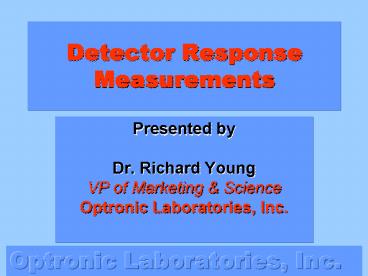Detector Response Measurements - PowerPoint PPT Presentation
1 / 18
Title:
Detector Response Measurements
Description:
... signal is virtually the same regardless where on the chip the light spot falls. ... detector and the calibrated detector require different holding fixtures. ... – PowerPoint PPT presentation
Number of Views:84
Avg rating:3.0/5.0
Title: Detector Response Measurements
1
Detector Response Measurements
- Presented by
- Dr. Richard Young
- VP of Marketing Science
- Optronic Laboratories, Inc.
2
Outline of Presentation
- Detector Types
- Response Uniformity
- Measurements
- Irradiance Response
- By substitution
- Power Response
- By substitution
- By beam switching
3
Detector Types
Detectors generally fall into two main types
Photodiodes
Photoconductors
4
Detector Types
- Photodiodes
- Can operate unbiased or biased
- Are generally suited to DC amplification
- Have low noise
- Generally operate in the UV to near IR
- Photoconductors
- Must be biased to operate
- Are usually operated in AC mode
- Have low sensitivity and high noise
- Generally operate in the visible to far IR
5
Response Uniformity
Photodiodes often have uniform responsivity
Note the z-axis scale is in 0.1 increments
6
Response Uniformity
Photoconductors often have non-uniform
responsivity
Note the y-axis scale is in 10 increments
7
Response Uniformity
Signal
For the silicon photodiode, the signal is
virtually the same regardless where on the chip
the light spot falls.
8
Response Uniformity
Signal
For the PbS photoconductor, the signal is very
different, depending where on the chip the light
spot falls.
9
Power Response
If the detectors were calibrated, we could
measure the power W in the spot, but
Si Detector
PbS Detector
- Power is measured correctly at all locations on
the chip - Power is measured correctly at all spot sizes
- Provided the spot lies within the detector area
- The spot location on the chip and spot size that
was used in the detector calibration must be
reproduced exactly for correct measurements
10
Irradiance Response
If the spot is larger than the detector area, the
detector measures Power Area Irradiance
(watt/cm2)
11
Irradiance Response
Provided the intensity within the spot is
uniform, the PbS detector also gives correct
irradiance results and is not sensitive to
alignment or spot size.
12
Irradiance Response
Detector calibration is usually done by direct
substitution. For irradiance response
calibration, the detector is over-filled with a
uniform beam
13
Power Response
Power reponse calibration is also usually done by
direct substitution. For power response
calibration, the detector is under-filled with a
small spot
14
Power Response
- However, if the detector is non-uniform, it needs
to be positioned correctly each time. - Often the test detector and the calibrated
detector require different holding fixtures. - And changing these, with alignment adjustments,
every time you need to calibrate can be time
consuming. - An accessory with a beam switch can speed up the
calibration/measurement cycle considerably.
15
Power Response
Calibrated Detector
Detector measurements with a beam switch requires
one extra step. First, the calibration as normal
then the beam is switched and the calibrated (or
other) detector is placed at the switched
position
16
Power Response
Measurement of the detector response in THIS
position is called a transfer calibration.
Calibrated Detector
17
Power Response
Once this is done, the detector remains in this
position. Calibration is achieved by applying the
transferred values.
Calibrated Detector
18
Power Response
Test Detector
Measurement is the same as before with the mirror
switched back.
Calibrated Detector































